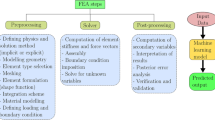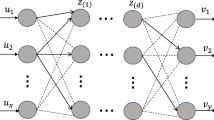Abstract
In the community of computational materials science, one of the challenges in hierarchical multiscale modeling is information-passing from one scale to another, especially from the molecular model to the continuum model. A machine-learning-enhanced approach, proposed in this paper, provides an alternative solution. In the developed hierarchical multiscale method, molecular dynamics simulations in the molecular model are conducted first to generate a dataset, which represents physical phenomena at the nanoscale. The dataset is then used to train a material failure/defect classification model and stress regression models. Finally, the well-trained models are implemented in the continuum model to study the mechanical behaviors of materials at the macroscale. Multiscale modeling and simulation of a molecule chain and an aluminum crystalline solid are presented as the applications of the proposed method. In addition to support vector machines, extreme learning machines with single-layer neural networks are employed due to their computational efficiency.













Similar content being viewed by others

References
Abraham FF, Broughton JQ, Bernstein N, Kaxiras E (1998) Spanning the length scales in dynamic simulation. Comput Phys 12(6):538–546
Ademiloye A, Zhang L, Liew K (2017) Atomistic-continuum model for probing the biomechanical properties of human erythrocyte membrane under extreme conditions. Comput Methods Appl Mech Eng 325:22–36
Akusok A, Bjork KM, Miche Y, Lendasse A (2015) High-performance extreme learning machines: a complete toolbox for big data applications. IEEE Access 3:1011–1025
Arroyo M, Belytschko T (2003) A finite deformation membrane based on inter-atomic potentials for the transverse mechanics of nanotubes. Mech Mater 35(3–6):193–215
Artrith N, Urban A (2016) An implementation of artificial neural-network potentials for atomistic materials simulations: performance for TiO 2. Comput Mater Sci 114:135–150
Badia S, Bochev P, Lehoucq R, Parks ML, Fish J, Nuggehally MA, Gunzburger M (2007) A Force-Based Blending Model forAtomistic-to-Continuum Coupling. Int J Multiscale Comput Eng 5(5):387–406
Bélisle E, Huang Z, Le Digabel S, Gheribi AE (2015) Evaluation of machine learning interpolation techniques for prediction of physical properties. Comput Mater Sci 98:170–177
Bogdanor MJ, Oskay C, Clay SB (2015) Multiscale modeling of failure in composites under model parameter uncertainty. Comput Mech 56(3):389–404
Chen C, Deng Z, Tran R, Tang H, Chu IH, Ong SP (2017) Accurate force field for molybdenum by machine learning large materials data. Phys Rev Mater 1(4):043603
Chen S, Cowan C, Grant P (1991) Orthogonal least squares learning algorithm for radial basis function networks. IEEE Trans Neural Netw 2(2):302–309
Hsu Chih-Wei, Lin Chih-Jen (2002) A comparison of methods for multiclass support vector machines. IEEE Trans Neural Netw 13(2):415–425
Cortes C, Vapnik V (1995) Support-vector networks. Mach Learn 20(3):273–297
Curtin WA, Miller RE (2003) Atomistic/continuum coupling in computational materials science. Modell Simul Mater Sci Eng 11(3):R33–R68
Ericksen J (1984) The Cauchy and Born hypotheses for crystals. In: Phase Transformations and Material Instabilities in Solids. Elsevier, pp 61–77
Fish J (2006) Bridging the scales in nano engineering and science. J Nanopart Res 8(5):577–594
Fritzen F, Kunc O (2018) Two-stage data-driven homogenization for nonlinear solids using a reduced order model. Eur J Mech A Solids 69:201–220
Ghaffari MA, Zhang Y, Xiao S (2018) Multiscale modeling and simulation of rolling contact fatigue. Int J Fatigue 108:9–17
Glielmo A, Sollich P, De Vita A (2017) Accurate interatomic force fields via machine learning with covariant kernels. Phys Rev B 95(21):214302
Goodfellow I, Bengio Y, Courville A (2016) Deep learning. MIT Press, Cambridge
Grabowski K, Zbyrad P, Uhl T, Staszewski WJ, Packo P (2017) Multiscale electro-mechanical modeling of carbon nanotube composites. Comput Mater Sci 135:169–180
Gracie R, Belytschko T (2011) An adaptive concurrent multiscale method for the dynamic simulation of dislocations. Int J Numer Meth Eng 86(4–5):575–597
Huang G-B, Zhu Q-Y, Siew C-K (2004) Extreme learning machine: a new learning scheme of feedforward neural networks. In: IEEE international joint conference on neural networks (IEEE Cat. No.04CH37541), vol 2. IEEE, pp 985–990
Gupta A, Cecen A, Goyal S, Singh AK, Kalidindi SR (2015) Structure-property linkages using a data science approach: application to a non-metallic inclusion/steel composite system. Acta Mater 91:239–254
Hansen K, Biegler F, Ramakrishnan R, Pronobis W, von Lilienfeld OA, Müller KR, Tkatchenko A (2015) Machine learning predictions of molecular properties: accurate many-body potentials and nonlocality in chemical space. J Phys Chem Lett 6(12):2326–2331
Hornik K, Stinchcombe M, White H (1989) Multilayer feedforward networks are universal approximators. Neural Netw 2(5):359–366
Hu R, Roshdibenam V, Johnson HJ, Eirola E, Akusok A, Miche Y, Björk KM, Lendasse A (2018) Elm-som: A continuous self-organizing map for visualization. In: International joint conference on neural networks (IJCNN). IEEE, pp 1–8
Huang G, Huang GB, Song S, You K (2015) Trends in extreme learning machines: a review. Neural Netw 61:32–48
Huang GB (2014) An insight into extreme learning machines: random neurons random features and kernels. Cogn Comput 6(3):376–390
Huang GB (2015) What are extreme learning machines? Filling the gap between Frank Rosenblatt’s dream and John von Neumann’s puzzle. Cogn Comput 7:263–278
Huang GB, Zhu QY, Siew CK (2006) Extreme learning machine: theory and applications. Neurocomputing 70(1–3):489–501
Ibañez R, Abisset-Chavanne E, Aguado JV, Gonzalez D, Cueto E, Chinesta F (2018) A manifold learning approach to data-driven computational elasticity and inelasticity. Arch Comput Methods Eng 25(1):47–57
Ibañez R, Borzacchiello D, Aguado JV, Abisset-Chavanne E, Cueto E, Ladeveze P, Chinesta F (2017) Data-driven non-linear elasticity: constitutive manifold construction and problem discretization. Comput Mech 60(5):813–826
Igelnik B, Pao YH (1995) Stochastic choice of basis functions in adaptive function approximation and the functional-link net. IEEE Trans Neural Networks 6(6):1320–1329
Jahya A, Herink M, Misra S (2013) A framework for predicting three-dimensional prostate deformation in real time. Int J Med Robot Comput Assist Surg 9(4):e52–e60
Jain A, Hautier G, Ong SP, Persson K (2016) New opportunities for materials informatics: resources and data mining techniques for uncovering hidden relationships. J Mater Res 31(08):977–994
Jiang S, Tao J, Sewell TD, Chen Z (2017) Hierarchical multiscale simulations of crystalline \(\beta\)-octahydro-1,3,5,7-tetranitro-1,3,5,7-tetrazocine (\(\beta\)-HMX): Generalized interpolation material point method simulations of brittle fracture using an elastodamage model derived from molecular dynamics. Int J Damage Mech 26(2):293–313
Kalidindi SR, Niezgoda SR, Salem AA (2011) Microstructure informatics using higher-order statistics and efficient data-mining protocols. JOM 63(4):34–41
Kelchner CL, Plimpton SJ, Hamilton JC (1998) Dislocation nucleation and defect structure during surface indentation. Phys Rev B 58(17):11085–11088
Le BA, Yvonnet J, He QC (2015) Computational homogenization of nonlinear elastic materials using neural networks. Int J Numer Meth Eng 104(12):1061–1084
Lendasse A, Wertz V, Verleysen M (2003) Model selection with cross-validations and bootstraps—application to time series prediction with RBFN models. In: Xu L, Kaynak O, Alpaydin E, Oja E (ed) Artificial neural networks and neural information processing—ICANN/ICONIP 2003. Lecture notes in computer science, vol 2714. Springer, Berlin, pp 573–580
Liu W, Karpov E, Zhang S, Park H (2004) An introduction to computational nanomechanics and materials. Comput Methods Appl Mech Eng 193(17–20):1529–1578
Liu WK, Qian D, Gonella S, Li S, Chen W, Chirputkar S (2010) Multiscale methods for mechanical science of complex materials: Bridging from quantum to stochastic multiresolution continuum. Int J Numer Meth Eng 83(8–9):1039–1080
Liu Z, Bessa M, Liu WK (2016) Self-consistent clustering analysis: an efficient multi-scale scheme for inelastic heterogeneous materials. Comput Methods Appl Mech Eng 306:319–341
Liu Z, Fleming M, Liu WK (2018) Microstructural material database for self-consistent clustering analysis of elastoplastic strain softening materials. Comput Methods Appl Mech Eng 330:547–577
Lorente D, Martínez-Martínez F, Rupérez M, Lago M, Martínez-Sober M, Escandell-Montero P, Martínez-Martínez J, Martínez-Sanchis S, Serrano-López A, Monserrat C, Martín-Guerrero J (2017) A framework for modelling the biomechanical behaviour of the human liver during breathing in real time using machine learning. Expert Syst Appl 71:342–357
Marcus G (2018) Deep learning: a critical appraisal. arXiv preprint arXiv:1801.00631
Matouš K, Geers MG, Kouznetsova VG, Gillman A (2017) A review of predictive nonlinear theories for multiscale modeling of heterogeneous materials. J Comput Phys 330:192–220
McDowell DL, Panchal J, Choi HJ, Seepersad C, Allen J, Mistree F (2010) Integrated design of multiscale, multifunctional materials and products, 1st edn. Butterworth-Heinemann, Oxford
Meng Q, Li B, Li T, Feng XQ (2017) A multiscale crack-bridging model of cellulose nanopaper. J Mech Phys Solids 103:22–39
Mielke SL, Troya D, Zhang S, Li JL, Xiao S, Car R, Ruoff RS, Schatz GC, Belytschko T (2004) The role of vacancy defects and holes in the fracture of carbon nanotubes. Chem Phys Lett 390(4–6):413–420
Miller RE, Tadmor EB (2009) A unified framework and performance benchmark of fourteen multiscale atomistic/continuum coupling methods. Modell Simul Mater Sci Eng 17(5):053001
Mishin Y, Farkas D, Mehl MJ, Papaconstantopoulos DA (1999) Interatomic potentials for monoatomic metals from experimental data and ab initio calculations. Phys Rev B 59(5):3393–3407
Plimpton S (1995) Fast parallel algorithms for short-range molecular dynamics. J Comput Phys 117(1):1–19
Rahman MM, Feng Y, Yankeelov TE, Oden JT (2017) A fully coupled space-time multiscale modeling framework for predicting tumor growth. Comput Methods Appl Mech Eng 320:261–286
Reich Y, Barai S (1999) Evaluating machine learning models for engineering problems. Artif Intell Eng 13(3):257–272
Rosenblatt F (1958) The perceptron: a probabilistic model for information storage and organization in the brain. Psychol Rev 65(6):386–408
Smola AJ, Schölkopf B (2004) A tutorial on support vector regression. Stat Comput 14(3):199–222
Song JH, Areias PMA, Belytschko T (2006) A method for dynamic crack and shear band propagation with phantom nodes. Int J Numer Meth Eng 67(6):868–893
Subramanian N, Rai A, Chattopadhyay A (2015) Atomistically informed stochastic multiscale model to predict the behavior of carbon nanotube-enhanced nanocomposites. Carbon 94:661–672
Tadmor E, Phillips R, Ortiz M (2000) Hierarchical modeling in the mechanics of materials. Int J Solids Struct 37(1–2):379–389
Tadmor EB, Miller RE (2017) Benchmarking, validation and reproducibility of concurrent multiscale methods are still needed. Modell Simul Mater Sci Eng 25(7):071001
Tadmor EB, Ortiz M, Phillips R (1996) Quasicontinuum analysis of defects in solids. Philos Mag A 73(6):1529–1563
Talebi H, Silani M, Rabczuk T (2015) Concurrent multiscale modeling of three dimensional crack and dislocation propagation. Adv Eng Softw 80:82–92
Tschopp M, McDowell D (2008) Influence of single crystal orientation on homogeneous dislocation nucleation under uniaxial loading. J Mech Phys Solids 56(5):1806–1830
Tsoumakas G, Katakis I (2007) Multi-label classification: an overview. Int J Data Wareh Min 3(3):1–13
Wagner GJ, Liu WK (2003) Coupling of atomistic and continuum simulations using a bridging scale decomposition. J Comput Phys 190(1):249–274
Xiao S (2006) A non-oscillatory method for spallation studies. Int J Numer Meth Eng 66:364–380
Xiao S, Andersen DR, Han R, Hou W (2006) Studies of carbon nanotube-based oscillators using molecular dynamics. J Comput Theor Nanosci 3(1):142–147
Xiao S, Andersen DR, Yang W (2008) Design and analysis of nanotube-based memory cells. Nanoscale Res Lett 3:416–420
Xiao S, Belytschko T (2004) A bridging domain method for coupling continua with molecular dynamics. Comput Methods Appl Mech Eng 193(17–20):1645–1669
Xiao S, Hou W (2006) Fracture of vacancy-defected carbon nanotubes and their embedded nanocomposites. Phys Rev B 73(11):115406
Xiao S, Hou W (2007) Studies of nanotube-based resonant oscillators through multiscale modeling and simulation. Phys Rev B 75(12):125414
Xiao S, Wang S, Ni J, Briggs R, Rysz M (2008) Reliability analysis of carbon nanotubes using molecular dynamics with the aid of grid computing. J Comput Theor Nanosci 5(4):528–534
Xiao S, Yang W (2006) Temperature-related Cauchy-Born rule for multiscale modeling of crystalline solids. Comput Mater Sci 37(3):374–379
Xiao S, Yang W (2007) A temperature-related homogenization technique and its implementation in the meshfree particle method for nanoscale simulations. Int J Numer Meth Eng 69(10):2099–2125
Yang W, Xiao S (2008) Extension of the temperature-related Cauchy–Born rule: material stability analysis and thermo-mechanical coupling. Comput Mater Sci 41(4):431–439
Zhou M (2003) A new look at the atomic level virial stress: on continuum-molecular system equivalence. Proc R Soc A: Math Phys Eng Sci 459(2037):2347–2392
Author information
Authors and Affiliations
Corresponding author
Additional information
Publisher's Note
Springer Nature remains neutral with regard to jurisdictional claims in published maps and institutional affiliations.
Rights and permissions
About this article
Cite this article
Xiao, S., Hu, R., Li, Z. et al. A machine-learning-enhanced hierarchical multiscale method for bridging from molecular dynamics to continua. Neural Comput & Applic 32, 14359–14373 (2020). https://doi.org/10.1007/s00521-019-04480-7
Received:
Accepted:
Published:
Issue Date:
DOI: https://doi.org/10.1007/s00521-019-04480-7



